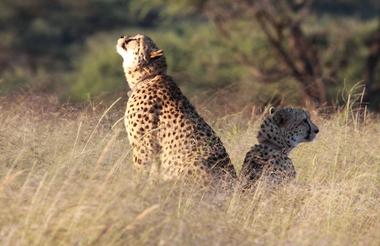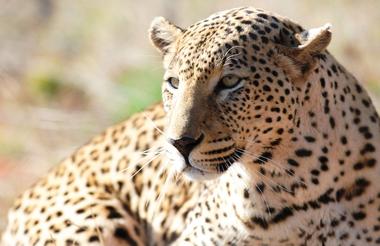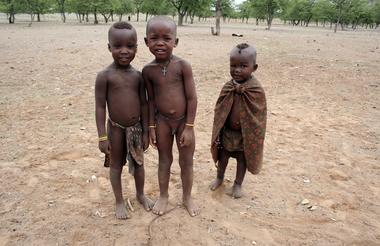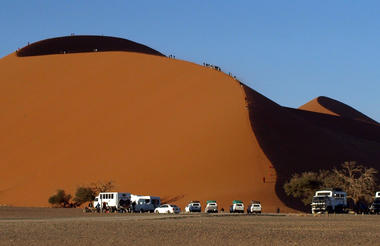Windhoek – Okonjima/Africat (300 km) (LD) (camping)
You will be collected between 08:30 & 09:00.
We will travel north, stopping at small towns along the way including Okahandja, where we have time to visit Namibia’s largest wood carving market. The market is operated on a local co-operative basis and is one of the best places to shop for truly Namibian souvenirs. Continuing north, passing through farmland, we aim to arrive at Okonjima during the middle afternoon, giving us time to set up our camp and to relax in the shade for a while before
heading out on to the property to take part in the afternoon’s optional activity.
Okonjima is the home of the Africat Foundation, a specialist conservation concern that centres its operations on the African Big Cats, particularly cheetah. This afternoon you will be taken on a tour during which you will be able to meet, close-up-and-personal, some of the cheetah that are going through the Africat rehabilitation programme.
Most of the animals currently living at Okonjima have been rescued from various desperate situations, being orphaned or caught in a trap, and the aim of the rehabilitation process is to attempt to re-introduce them into the wild.
After our educational tour we will return to our camp and prepare for dinner under the African stars.



Okonjima/Africat – Namutoni / East Etosha region (300 km) (BLD) (camping)
An early start and continuing north we pass through some small towns, making short stops for fresh supplies and fuel. Continuing on to our East Etosha, Namutoni region camp we again aim to arrive in time for lunch, giving us time to relax before heading into the park during the cool of the late afternoon for our first game drive.



East Etosha region – Okaukuejo, Etosha National Park (BLD) (camping)
A full day’s game driving. We again leave early to enjoy the cool morning air as we game drive our way through Etosha to Halali camp, situated in the middle of the park. Along the way we visit several waterholes and are afforded splendid views of the massive Etosha Pan. The game viewing is usually excellent and we have the chance to tick off a few new species that are not normally seen on the Namutoni side of the park.
We stop at Halali for a rest and a leisurely lunch. There is time to visit the Halali waterhole and to make use of the swimming pool and bar facilities before continuing on our way and game driving down to Okaukuejo, Etosha main rest camp and resort where we will check in and set up camp. Originally the site of a German fort built in 1901, Okaukuejo now houses the Etosha Ecological Institute, founded in 1974; the round watchtower is a remnant of the
fort.
After your evening meal there are still more chances to see Etosha big game at a floodlit waterhole, situated on the boundary of our camp and easily reachable within a minute or two on foot.
The waterhole has been described as one of the “best game viewing opportunities in Southern Africa” and the ideal venue to witness peculiar animal politics. Black rhino, Africa’s tallest elephants, lion and numerous species of antelope are regular visitors during the cool, dry season.



Okaukuejo – Grootberg area (310km) (BLD) (camping)
Leaving Etosha we begin our journey south with a relatively short drive to the small town of Kamanjab.
Within this area you have the opportunity of visiting a Himba Village – the only traditionally functioning Himba community outside the far north Kaokoland region of Namibia These tribes-people have migrated here, lifestyle and customs intact, and are following their traditional way-of-life in their village on a farm, the exact location of the site varies as the Himba occasionally roam to a new location. We will learn about marriage customs, traditional food and
the mysteries of the “Holy Fire” religion.
From here it is a short drive on to The Hoada Community Campsite which is located among beautiful granite hills and mopane trees. To add an eco-friendly touch, the hot water system works in combination with the barbecue area, therefore whilst your meal is being prepared, your water will be warmed up for your shower!
We overnight – camping under the stars.



Grootberg area – Twyfelfontein (190 km) (BLD) (camping)
Today we head into one of the most beautiful desert regions in Namibia, Damaraland. We drive west via the Grootberg Pass and then take a detour to visit the ancient Bushman rock engravings at Twyfelfontein. At this location we will have a local guide to conduct us on a short guided tour before we set up camp for the night.



Twyfelfontein – Swakopmund, Skeleton Coast (420 km) (BL) (accommodation)
From here we head deeper into the desert and pass Namibia’s highest mountain, The Brandberg, (2573 m) and more beautiful Damaraland scenery. We make a stop in the small town of Uis, an old mining town, and one of the best places to buy semi-precious stones, for which Namibia is famous. Here, rough Amethyst, Tourmaline etc can be found at bargain prices.
From here we turn directly west and cross the gravel plains on our way to the Atlantic Ocean and the Skeleton Coast.
Meeting the ocean at Henties Bay, we first head north along the coast to visit the seal colony at Cape Cross. At certain times of the year as many as 100,000 Cape Fur seals congregate.
The next destination is Swakopmund, following the Skeleton Coast into Namibia’s premier seaside town. We aim to arrive in the late afternoon giving us time to explore the town on foot before sunset.
Tonight we take the chance to sample one of the excellent restaurants. The seafood in Swakopmund is superb. Your guide will offer to organise a group meal in a local restaurant for this evening. Participation is recommended but by no means required.
Dinner is for the client’s own account.



Swakopmund (B)
Today is a free day. The idea is to allow time for everybody to do their own thing. Swakopmund is a very pleasant seaside town with lots of shops, a good stretch of beach (although the Atlantic here is quite cold) and an open-air curio market. There is also a very good museum and the Namibian National Marine Aquarium is located in Swakopmund.
Alternatively, there are various optional activities that can be arranged. These include aeroplane and microlight flights over the desert, scenic drives, fishing trips (both from the beach or in a boat), four-wheel motorcycle (quad bike) trips into the desert and over the sand dunes around Swakopmund, sand boarding trips (also in the dunes), skydiving, surfing, bird-watching and many other activities are available.
Your tour guide will discuss all the possible options with you before you reach Swakopmund and will offer to make bookings in advance of your arrival. (N.B. All extra activities and excursions in Swakopmund are subject to availability and are made at the clients’ own risk and expense).
Lunch and dinner today is not included in the price of the safari and will be for the client’s own account


Swakopmund – Sesriem (300 km) (FB) (camping)
Our first stop is at Walvis Bay, situated about 40 km south of Swakopmund. South of the town there is a large marine lagoon which is home to a vast array of marine bird-life, in particular flamingos.
We will make a short visit to the lagoon to see the birds and a short visit to Walvis Bay to collect any last minute supplies before once again heading out into the desert. The second part of our journey today takes us across more of the seemingly endless Namib gravel plains. Then the landscape suddenly changes and we are into the mountain desert.
The tour continue as we traverse both the Kuiseb and Gaub passes, driving both times to the river beds at the bottom of the canyons and then climbing the long steep road to the top and the spectacular panoramas the mountains give us. Again the scenery changes as we make our way down to the dune fields. We cross some open grass savannah and farmlands before the terrain begins to give way to the immense red sand dune desert of the Namib and from here it is only a short distance to our next stop, the tiny town of Solitaire.
Our aim is to arrive at our camp during the late afternoon and watch the colours glow and change on distant mountains to the east.


Sesriem – Windhoek (450 km) (BL)
After breakfast we begin our journey over the mountains and along scenic roads, back to Windhoek. We stop at Solitaire to stretch our legs then proceed back to Windhoek via the Khomas Hochland Mountain range back to civilization. We are due back into the city late afternoon / early evening and you will be dropped off at your accommodation on our return.





